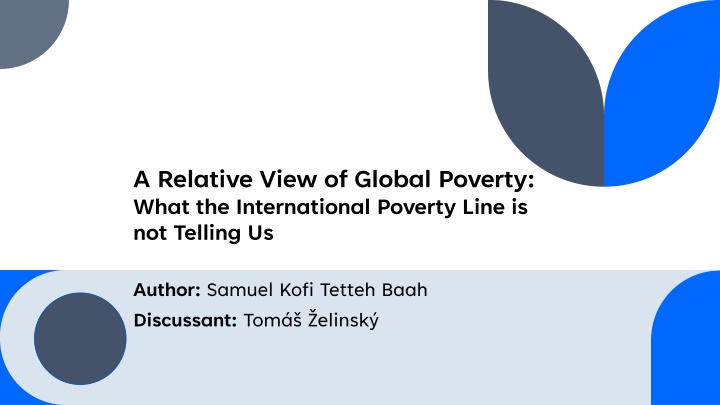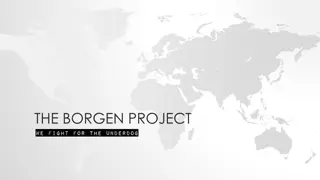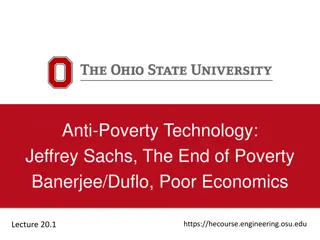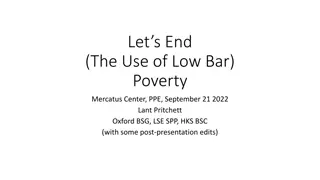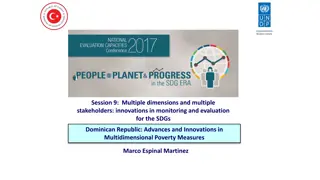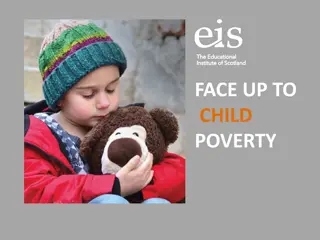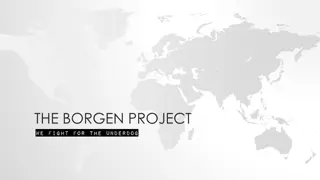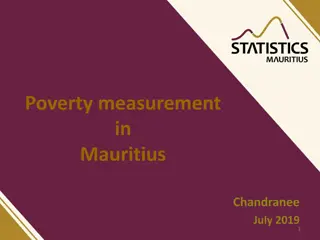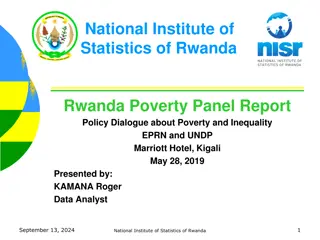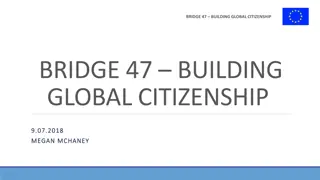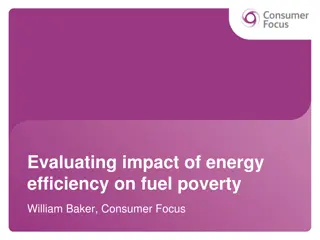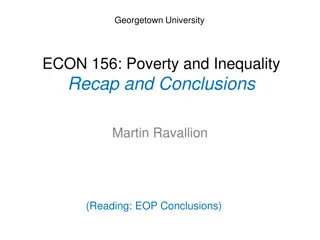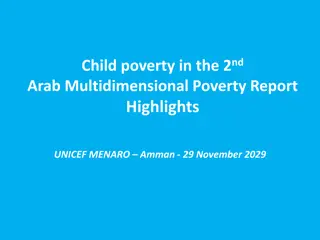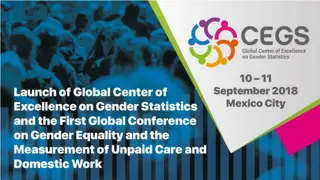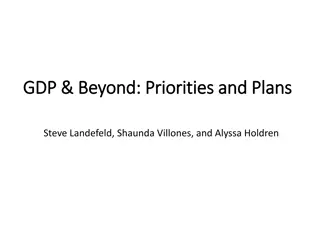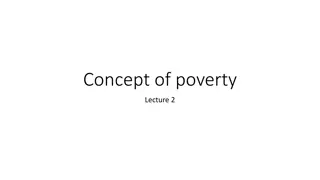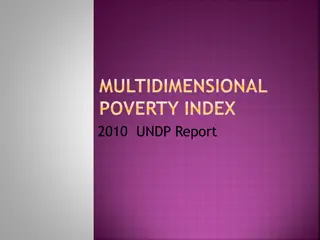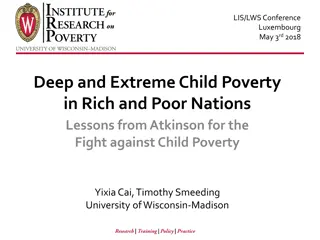Global Poverty Perspectives: Rethinking International Poverty Measures
Delve into the complexities of global poverty analysis beyond the international poverty line. Explore the impact of relative versus absolute poverty perspectives, the debate on country-specific poverty lines, and the evolving strategies for poverty reduction in a shifting global landscape.
Download Presentation

Please find below an Image/Link to download the presentation.
The content on the website is provided AS IS for your information and personal use only. It may not be sold, licensed, or shared on other websites without obtaining consent from the author.If you encounter any issues during the download, it is possible that the publisher has removed the file from their server.
You are allowed to download the files provided on this website for personal or commercial use, subject to the condition that they are used lawfully. All files are the property of their respective owners.
The content on the website is provided AS IS for your information and personal use only. It may not be sold, licensed, or shared on other websites without obtaining consent from the author.
E N D
Presentation Transcript
A Relative View of Global Poverty: What the International Poverty Line is not Telling Us Author: Samuel Kofi Tetteh Baah Discussant: Tom elinsk
Lets begin with a few questions: Why is it important to know how many people around the world are living in poverty? Do we need internationally comparable statistics on poverty? Should we use a universal poverty line for all countries, or should national poverty lines be adopted? Is an absolute poverty line preferable to a relative one? Should the absolute poverty line reflect the same basic needs across all countries? 30/8/2024 A Relative View of Global Poverty 2
MOTIVATION Distribution of global poverty in 2019 Absolute poverty international poverty line Weakly relative poverty societal poverty line 30/8/2024 A Relative View of Global Poverty 3
MOTIVATION Should the international poverty line focus on poor countries or poor people? Historically, targeting poor countries was sufficient does this still hold true? There is a growing share of rich individuals in poor countries and poor individuals in rich countries. A shift in focus from the poorest countries to the poorest individuals within each country. Should fewer resources be allocated to poverty reduction in Africa? This depends on whether we prioritize addressing absolute or relative poverty. Applying different standards across countries can exacerbate global inequality. Sub-Saharan Africa remains significantly poorer in non-monetary dimensions. 30/8/2024 A Relative View of Global Poverty 4
How it all began National poverty lines and household consumption are reported in local currencies. Purchasing power parity (PPP) exchange rates convert these figures into a common currency, accounting for price differences more accurately than market exchange rates. New PPPs are collected periodically, with the most recent update in 2021. When PPPs are updated, the international poverty line is also adjusted. Currently, the World Bank uses 2017 PPPs. 5
Global poverty lines Median ($) (2017 PPP) 2.15 Rounded Income classification Observations Low income (LIC) 2.15 28 Lower-middle income (LMIC) 3.65 3.63 54 Upper-middle income (UMIC) High income (HIC) 6.85 24.35 6.85 24.36 37 38 6
When absolute becomes relative Though absolute poverty lines, the international poverty line and higher lines reflect the idea of relative poverty, the fact that the concept of poverty varies by income. In other words: As countries get wealthier, the standard of meeting basic needs increases. The wealthier a country, the more resources one needs not to avoid social exclusion. A complementary measure of poverty based on a societal poverty line. 30/8/2024 A Relative View of Global Poverty 7
When absolute becomes relative Societal poverty line (SPL): Introduced by the WB in 2018. It combines elements of both absolute and relative poverty (weakly relative poverty). Societal poverty line = max($2.15, $1.15 + 50% of median) 30/8/2024 A Relative View of Global Poverty 8
Four alternative poverty lines (1) International poverty line (2) Income-group-specific poverty line (3) Societal poverty WITH a floor (4) Societal poverty WITHOUT a floor 30/8/2024 A Relative View of Global Poverty 9
Data and coverage Main data sources 168 countries with survey data Global Monitoring Database (GMD) 153 countries Luxembourg Income Study (LIS) 9 countries Grouped data 8 countries Over 97 percent of the world s population in 2019 Poverty and Inequality Platform (PIP), version March 2023 CPI, PPP, population, national accounts data Supplementary data sources National poverty lines WDI Year of schooling WDI Learning-adjusted years of schooling (Filmer et al. 2018) 10
Robustness: National vs. international poverty rates Dependent: National poverty rate 14
Schooling vs. international poverty rates Dependent: Years of schooling 15
Observations: Introduction (Conceptual framework) As a reader, I would appreciate a discussion on absolute versus relative poverty lines. As suggested, the distinction between the two can be subtle, and an absolute poverty line can easily shift into relative. Another point to consider: Expand the discussion on the comparability of basic needs across different countries. 30/8/2024 A Relative View of Global Poverty 16
Observations: Data and Methods Consider including Supplementary Material that summarizes approaches to constructing national poverty lines. Although you reference other studies, a quick summary could be helpful (since not everyone will take the time to look them up). 30/8/2024 A Relative View of Global Poverty 17
Observations: Results Consider adding Supplementary Material with poverty estimates based on the four poverty lines for all countries in the study. People often want to see how their country compares to others. Section 5.2 Consistency of competing poverty series with related indicators While examining the correlation between alternative poverty lines and [years of schooling] is valuable, readers may have varying opinions on the relevance of various covariates. Consider either excluding this section or exploring it in a different paper? 30/8/2024 A Relative View of Global Poverty 18
Observations: Conclusion The Bank faces a dilemma in presenting poverty data. If it publishes poverty numbers that are considered too low, observes might say the Bank is presenting good poverty numbers to show that it is being successful in reducing poverty around the world. On the other hand, if it publishes poverty numbers that are considered too high, some observers might also say the Bank is doing that to remain in business. Consider addressing this in the introduction or conceptual framework by explaining the importance of having precise global poverty figures, while also highlighting that understanding trends may be more significant for policy implications. 30/8/2024 A Relative View of Global Poverty 19
